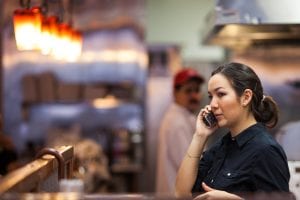
Photo by Thomas Hawk via Flickr. CC BY-NC 2.0
When COVID-19 began spreading across the country earlier this year, and Americans were ordered to stay at home and socially distance, they turned to technology. Since then, many aspects of everyday life have become virtual–starting with work and school and eventually including traditionally in-person events like baby showers, birthdays, and weddings; cooking and fitness classes; conferences; concerts and plays; and even dance parties. A Pew Research Center survey conducted in early April found that roughly 54 percent of U.S. adults said that the internet became essential for them during the pandemic.
As the pandemic pushed people to rely more heavily on technology to stay connected, it also made it undeniable how much more work needs to be done to resolve the digital divide. In a report published last year, the Federal Communications Commission estimated that there were 21 million Americans who lacked broadband access at the end of 2017. Reliable high-speed internet, as defined by the FCC, is having download speeds of at least 25 megabits per second (Mbps) and upload speeds of at least 3 Mbps. In other words, having high-speed internet access is a luxury. This has become especially apparent in the country’s education system. It’s estimated that more than 9 million schoolchildren lack access to high-speed broadband internet at home. According to the Pew Research Center, those who are less likely to have broadband service at home include racial minorities, older adults, rural residents, and those with lower levels of education and income.
Closing the digital divide requires reliable and affordable internet, adequate devices, and digital literacy skills. Outside of schools and libraries, nonprofit organizations are often the bridge for the digital divide in their communities. However, that work has become more challenging as face-to-face gatherings have been restricted. Nonprofits were forced to innovate with creative methods for staying in contact with their constituents who lack internet access. Some are leaning on tried and true practices such as phone calls and direct mailing to share important information. Others are using newer tools like podcasting to spark engagement and provide a sense of connection. Education around digital literacy hasn’t waned either, as nonprofits continue to teach people how to use digital tools like Zoom so they aren’t left behind.
Spreading the Word
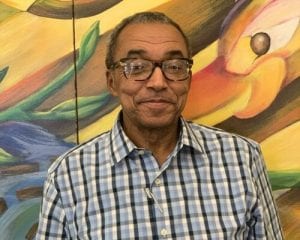
Jose Barros. Photo courtesy of the Dudley Street Neighborhood Initiative
Before COVID-19 became a worldwide epidemic, community organizations around the country were focused on reminding people to respond to the census. In March, Jose Barros, community organizer and planner for the Dudley Street Neighborhood Initiative in Roxbury, Massachusetts, was calling residents using a database of registered voters to remind them about completing the 2020 census. But as news of the virus spread, he realized how much people appreciated hearing a friendly voice when he called. Though Barros called to discuss the census, he found that people wanted to talk about the virus.
In response to COVID-19, Dudley Street continues to use phone banking to check in with residents about their needs and provide access to resources. They started providing stipends to recently unemployed residents who could join the organization’s phone banking effort. Barros says that Dudley Street also started mailing residents a resource list and joined a collaborative of about 15 organizations from across the city to provide food and financial resources to immigrant families across Roxbury and North Dorchester.
The collaborative, named the Boston Immigrants COVID-19 Collaborative (BICC), was funded by the city of Boston and the Boston Resiliency Fund to enable the organizations to provide a variety of resources. “We’ve been distributing food, distributing money… anything they need … toiletries and diapers for kids,” explains Barros. Residents can also “apply for a rent relief fund that will pay up to $4,000 if they qualify.”
A downside to using phone banking, says Barros, is when numbers in the database no longer work. He says that he’s noticed more residents using only cellphones because they are unemployed and cannot afford to have both a landline and a cellphone. “It’s an issue because you can’t reach out to those people because we don’t have their cellphone number,” Barros says.
However, Barros adds that Dudley Street is getting a lot of calls from new residents inquiring about help. “There is a lot of need,” he says. “Everyone is suffering. So in talking to their friend, they [hear] that organizations are giving food or giving money.”
Another tool that Barros uses to connect with people is Facebook. Many residents can access the site on a mobile phone. “Facebook, for a lot of people, is a way to reach out to residents,” he says. “For example, I get information from the city of Boston that is translated in many languages. So I take [a post] for the Cape Verdean community and repost it. It’s a way that we can reach out to a lot of people because they don’t have other ways. They don’t have a computer … you cannot reach out to them through other media sources.”
As of 2019, 96 percent of Americans own a cellphone of some kind and more specifically, 81 percent of Americans own a smartphone. However, according to the Pew Research Center, roughly one in five adults are smartphone-only internet users, meaning they own a smartphone but do not have home broadband service. Of lower-income adults–those who make less than $30,000 a year–26 percent rely on smartphones for online access. Twelve percent of adults over the age of 65 rely on smartphones for internet.
Since smartphones are the primary tool for communication, Elba Schildcrout, director of community wealth and services for the East LA Community Corporation, has found that text messaging is an easier and faster way to contact people. Her organization created a Google number to text clients and remind them of their appointments.
“We saw responses go up significantly when we started texting people,” she says. “Text has really saved so much time and has made it so much easier to contact people.”
You’ve Got Mail
The People’s Emergency Center Community Development Corporation in West Philadelphia has been doing digital inclusion work since 2004, and commonly uses low-tech tools like text messaging. “We know that not everyone we need to reach is online frequently,” says communications director Trish Downey. “We cover an area that’s high in poverty [and] and an area [with] a lot of elderly people.”
Another low-tech tool PEC has used for the past five years is a monthly resource booklet. The 24-page booklet contained information about PEC’s services, as well as services available through other nonprofits in the city. PEC distributed about 3,000 booklets per month at outreach tables at events where people could pick up a stack to hand out to other residents. The booklets were also given out at high-traffic retail spots where PEC would put them out for people to take.
PEC published and distributed its last booklet in March. After going door to door and hosting events became prohibited, Downey says she and her team members questioned how they could still get critical and relevant information out the community, especially around COVID. They decided to create and distribute a newsletter to send to residents via mail.
Compared to the monthly resource booklet, the April newsletter was only six pages and had information about the virus, the 2020 census, ways for people to stay connected, important voting dates, and business resources. PEC mailed the newsletter to 5,000 households. Producing it did not require PEC to change departments or funding. Most of the production and mailing is handled by their printer, where it is printed, folded, put into envelopes, and delivered to the post office.
“We want to continue doing the mailer instead of going back to the booklet,” says Downey, who works on the newsletter with PEC’s digital inclusion manager. “With the same amount of money, we can reach more people and it seems to be the most effective in getting information out there.”
The second newsletter went out last month and included a survey to understand how residents feel about it and if it has been helpful.
Podcasting Sparks Engagement

Scott Oshima. Photo courtesy of the Japanese American Cultural and Community Center
Once the shelter-in-place order went into effect in March, the Japanese American Cultural and Community Center (JACCC) in Los Angeles started working with its partner, the Little Tokyo Service Center, to come up with a creative way to combat the loneliness associated with social isolation for the seniors they serve. Normally, JACCC has two programs for seniors, ages 65 and up, that focus on combating that. One program is called ukuleles for Little Tokyo, a free program that teaches ukulele to seniors; and Shodō for Little Tokyo, a free calligraphy workshop. Both programs were halted in March.
“We were like, oh no!” recalls Scott Oshima, director of the Sustainable Little Tokyo Program. “We’re in a time when everyone has to socially isolate, but this a population that’s so vulnerable and so in need of programs to combat exactly that. How can we very quickly find a way to reach them and provide some arts and culture, and some support and some messages of hope?”
The Arts Action Committee for Sustainable Little Tokyo–which is made up of about 15 local artists who advocate against displacement and for sustaining the arts, culture, and history of Little Tokyo–suggested doing a podcast for the seniors. Oshima says the committee took on the task of quickly creating the podcast, noting that “we have all of the partnerships and artists that we could possibly need to build a podcast.” The group used their own equipment and tools, including phones, audio editing software called Audacity, and the CCTV system already built into Little Tokyo Towers, a senior apartment building.
To make the podcast as accessible as possible, the group chose the Bullhorn platform so that people could use a phone call-in option. With Bullhorn, listeners can use a phone number to listen to the podcast itself. The podcast launched on April 13 and has several segments, including an exercise segment for the seniors to do radio calisthenics and a haiku challenge for people to submit and share. There’s a segment on general updates in the neighborhood, and one that features a local musician who can play a song and share a message with the seniors. Community members can use a call-in number to leave a message, make a song request, or share a haiku poem.
“That’s the framework to offer a little message of care and that we’re still here for [the seniors],” says Oshima.
Two podcast episodes are released each month on the second and fourth Fridays. It’s broadcast in four languages–Japanese, Korean, Spanish, and Mandarin. Oshima says that the podcast had about 1,000 listeners in its first month. The idea when the podcast first launched was to do it until October, but Oshima says that the podcast will continue for as long as the seniors are sheltering in place.
Through the process of creating the podcast, Oshima says the group had surveyed around 50 seniors to know how to reach them. “We had to do a survey with our ukulele and calligraphy students to say, ‘What do you have access to? Do you know how to use Zoom? Do you have a cellphone? Do you have a landline?’ It was learning what residents have access to.” From the survey, they learned that about 30 percent of the seniors use Zoom, usually on their phones, and most were comfortable using email. Oshima says JACCC opted for the phone call-in option to provide accessibility to everyone.
The reception to the podcast has been positive, but Oshima says the downside is not being able to have in-person interaction with the seniors. The podcast team is mindful that sitting on a phone listening to a 20-minute podcast may not necessarily be the most enjoyable way to experience art, so the podcast is also played on the CCTV system. The CCTV system is hooked up to the senior residents’ TVs, and JACCC posts flyers and occasionally make announcements on the building’s PA system.
“It’s quite a production and it takes a community effort of people who really care about this work,” Oshima says.
Using Video to Educate
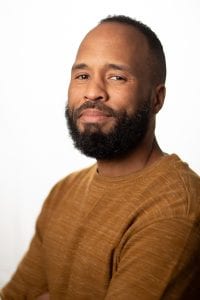
Greg Corbin. Photo by Steve Weinik
To accommodate restrictions on gatherings, nonprofits are converting digital literacy training that would usually be done in-person to video conferencing. Mural Arts Philadelphia, which uses art to ignite change in the city, has a restorative justice program that works with returning citizens between the ages of 18 and 45. Under the restorative justice program, there is a four-month paid apprenticeship program called the Guild. It provides mentorship and the ability to develop job skills like entrepreneurship, brand building, and marketing. Members of the Guild work on creative projects such as mural making, carpentry, and mosaics.
According to Greg Corbin, director of restorative justice, Mural Arts took a program that traditionally depends on person-to-person interaction and “moved it virtually almost overnight.”
“For us, the digital piece is where we really were able to pivot,” Corbin says. “We had to learn quickly how to navigate the digital space. … The way we were able to pull it off is very interesting.”
Corbin says the program is using videoconferencing via Zoom and Google classroom. But not everyone had the software at first, and the staff had to make sure that program participants, referred to as the Guild employees, downloaded it on their phones. Over video conferencing, sessions are held with the Guild employees on personal and professional development. For example, the Guild employees are taught about email etiquette and are given assignments like sending a mock email. Speakers were brought in to talk about social media presence and their digital footprint. Corbin says the Guild employees also created their own LinkedIn pages.
“Keeping the integrity of the programming was extremely important,” Corbin says. “We knew that if our programming went away, it would be easier for the people in our program to recidivate.”
Since the pandemic, the East LA Community Corporation has also used Zoom to stay connected with its clients and continue offering services like tax preparation, homeownership counseling, and financial coaching. Schildcrout says that when the ELCC staff first started working virtually, they were concerned that a lot of their clients—who are 85-90 percent Latino and monolingual—would not be able to access their programs and services because of the digital divide. But they learned that most of them have a smartphone and she was surprised to find that clients were willing to connect over Zoom.
[RELATED: How Nonprofits Are Adapting to Serve Immigrants During COVID]
However, Schildcrout notes, sharing confidential documents is a challenge. She often deals with clients’ tax returns, and sometimes clients will ask if they can send a picture of the documents over text or email it to her.
“It feels really good that they can trust us in sending us their documentation that way,” says Schildcrout. “I’m very careful about a person’s information, and my concern is confidentiality and making sure that we honor their personal information and that they trust us.”
Schildcrout says that she is looking at different ways to make it easier for clients to share personal information with her, like a shared drive or a portal where they can upload documentation. “That’s one of the big things that I still haven’t completely figured out.”
While working with clients and their sensitive documents, Schildcrout uses DocuSign to get her clients to digitally sign them, although not all of her clients know or understand how to use it. Schildcrout frequently coaches clients on using the tool or asks if the person’s son or daughter can help them.
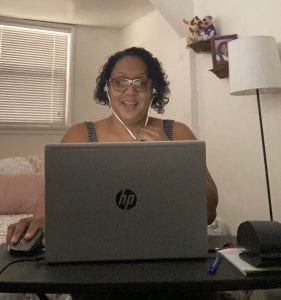
Cindy Adame, a Financial and Small Business Coach at the East LA Community Corporation, works from home. Photo courtesy of the East LA Community Corporation
“Before the pandemic, we had talked about doing video coaching and counseling, but we’d never really [pursued] it,” says Schildcrout. Now, having been forced to take the plunge, ELCC has decided to keep doing it, and is looking at different software options for its different activities. “It just gives people more access and I feel like the younger generation is more open to it and would rather have everything done online.”
The People’s Emergency Center is also navigating the process of converting in-person training into an online format. Prior to COVID, PEC had a computer lab where training was offered to the public. Downey explains that PEC is one of several neighborhood partners for an initiative called the West Philadelphia Action for Early Learning (AFEL), a collaboration of social service and education agencies and community stakeholders working to create an education support system for students and families. She says AFEL had regular engagement with grandparents who are caregivers of children up to age 8. Since AFEL is not able to meet with them in person, they opted to use Zoom. However, their constituents were not familiar with Zoom.
“One person [from AFEL] individually contacted people to make sure they could set up [Zoom] on their smartphone – if they have a smartphone – [and] help them use it,” Downey explains. “She’s working with people over the phone to show people how to use their phones. That’s the kind of work you have to do to bridge the divide right now.”

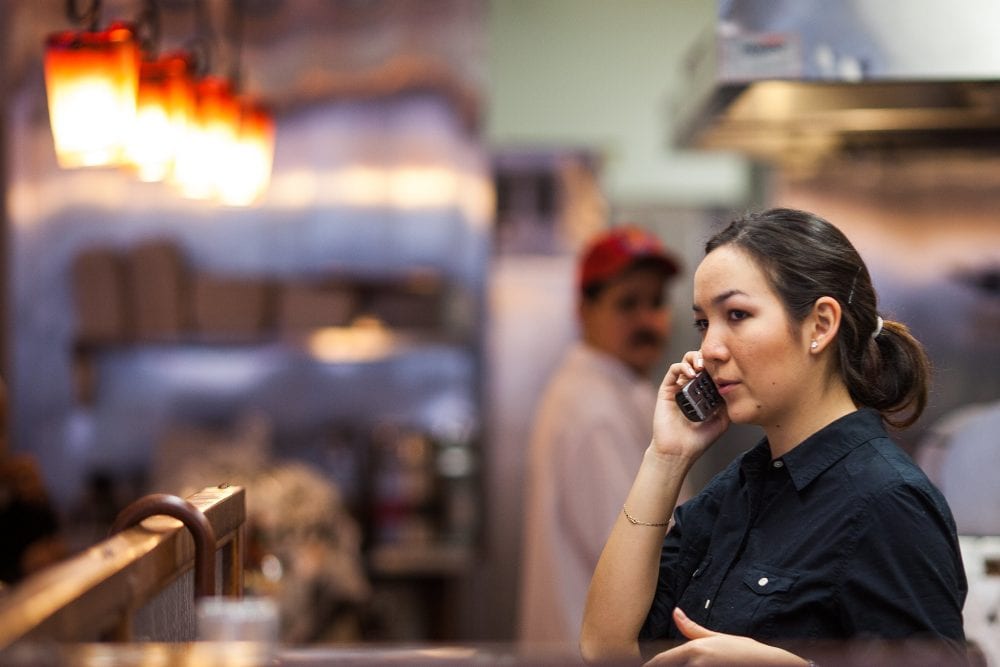




Comments